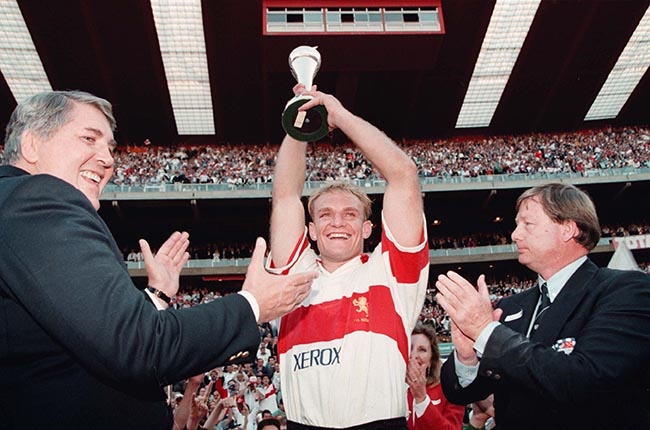


Francois Pienaar lifts the 1993 Super 10 trophy after Transvaal beat Auckland 20-17 at Ellis Park (Gallo Images)
Comment: Rob Houwing, Sport24 chief writer
While he still has plenty to prove as a first-time head coach at Super Rugby level this year, few would disagree that the Stormers’ John Dobson has a sharp, sometimes unorthodox and creative mind.
Register your interest for the British & Irish Lions tickets in South Africa 2021
He would have earned widespread nods earlier this week when he lamented that the once-buzzing competition “has deteriorated over the last (few) years … beyond doubt”.
But there was also a tempering factor to his views – and one I no less strongly concurred with. He added that the competition, for all the scorn it receives these days, doesn’t deserve to have the plug pulled on it.
I have long argued personally that while Super Rugby has steadily lost far too much of its champagne factor (governing body Sanzaar no angels in that regard for the near-constant fiddling, expansion and other generally contrived interventions) it remains, when all is said and done, a decent enough product.
Why wouldn’t it be? It still pulls together many of the best rugby players in the world, significantly drawn from territories that account for all but one of the nine World Cup title successes so far … England’s triumph in 2003 the lone exception to the rule.
But that “many” I mentioned is far from irrelevant. In the earliest days of Super Rugby – stretching back to Super 10, when Transvaal won the first silverware in 1993 – you were far more easily able to boast “all”.
At that specific time, virtually all the major international stars from the three traditional southern hemisphere superpower countries also played in Super Rugby (primitive, raw and naïve in some ways though the tournament may still have been).
Andre Joubert, Hennie le Roux, Uli Schmidt, Michael Jones, Sean Fitzpatrick, Tim Horan, John Eales: it was almost unthinkable then to imagine them playing their state, franchise or provincial rugby in Europe or Japan.
So Super Rugby was able to grow and flourish, arguably culminating in the period Dobson, for one, regards as its nirvana: as Super 12 between 1996 and 2005. In his words: “First prize was Super 12 … top four, semi-final, final, over by the end of May, no break in between.”
It is history now (and unfortunately so?) that the administrators, no doubt cajoled every step of the way by live-action-hungry television bosses, got greedy, as the tournament expanded to a reasonably brief all-time high of 18 teams and clumsy conference models – before significant trimming became such an obvious need to ease the gross dilution of standards.
Easily the biggest, ever more encroaching problem plaguing Super Rugby these days, as I see it, is the accelerating degree of defections of big-name players – and especially those of Springbok and Wallaby frontline status – to clubs on the northern side of the equator.
Next year, as some damage limitation, Super Rugby will see the desperately seldom competitive Sunwolves culled, a step back in the right direction as conferences are abandoned and 14 sides play on a simpler-to-follow, round-robin basis once again.
It’s an apt enough fresh start and better direction, though “Dobbo” would clearly prefer an ideal of a dozen franchises again.
Yours truly? Considering just how many big-name players have migrated northward in recent years, I believe that you’d really need to compress it even further: to 10 teams, the 1993-95 structure, if you genuinely wished to emulate the crackle of 20 or 25 years ago in Super Rugby when every match genuinely was an “event”.
That’s extremely unlikely to happen … but here, anyway, are my own thoughts of an “ideal world” for the present-day competition, given the vast reduction in truly blue-chip player names available to squads.
My 10-team utopia would (and I risk shedding an Argentinean friend or two over this) exclude the Jaguares, the lone team from one isolated continent who force considerable extra travel for competing outfits, and who contentiously all come together again in the different shirt of the Pumas for the Rugby Championship later every season.
Frankly, I would prefer to see their national team somehow get better exposure on the international roster … even if their domestic rugby would take a considerable hit, I grant you, through an elbowing from Super Rugby.
So my ideal structure, then, would see four (down from present five) New Zealand teams: two from each of the north and south islands (thus Crusaders, Highlanders, Hurricanes and some sort of joint set-up between the Blues and Chiefs, not too far apart geographically).
In Australia, I would shrink four into three: Reds, Rebels and a combination, like it or not, of the Brumbies and once-were-mightier Waratahs.
South Africa? We’ve been particularly badly hit by the trek of players to Europe and Japan, and the brutal truth, I feel, is that three franchises might be enough to stave off any compromising on quality: Sharks, Stormers and (I know, I know, wince now, you Bulls and Lions diehards!) a single Highveld super-franchise featuring the best of Pretoria and Johannesburg with their home games split between Loftus and Ellis Park.
That’s my thoroughly revitalised, go-back-to-go-forward Super 10.
But dream on, I guess …
*Follow our chief writer on Twitter: @RobHouwing

